
About Us
Contact Us
Events
Products
Scythe Buyers' Guide
Technical/
Instructional
Updates
Video
Home
Scythe Blades
Yes, we do understand that the diversity of blades listed here may be confusing, and making a choice seems overwhelming. Why so many blades - and which is right for you??
We have written numerous essays in order to help clarify various technical issues pertaining to blade choices -- and strongly urge you to read them BEFOREHAND; they may be found here. If, however, you would rather not read anything beyond the actual product descriptions (some people have told us they "don't have time"), then we can only help you so much... In that case you still have at least two options: purchase a scythe from a source where choices are simpler -- or simply consider this catalogue the equivalent of walking, somewhat uninformed, into respective specialty stores handling shoes, bicycles, fishing equipment, etc. Do the people operating them (unsure as they may be of their customers competence to make the best choice) offer only one or two models/versions of each of their respective items? Of course not. Amongst the mail-order tool suppliers, for instance, Lee Valley Tools presents 200 different chisels to their woodworking customers, Lehman's Non-Electric catalogue carries over 70 different lamp shades and the online knife-specialty sources can make a knife-eyeing amateur quite dizzy with options. The examples are endless.
Well, we break the established rules when it comes to scythes and join the complexity-prone crowd. We feel justified doing so, because we've put considerably more energy towards educating the public about scythes than selling them. We also do not sell anything (to the point of turning down a potential sale) that we think may be a poor choice (or a needless addition) for any specific customer -- an approach requiring also more time than has been accepted as "realistic". Given such guidelines, offering many choices is only natural. Although such diversity is not necessary, our selection, as we see it, ought to be viewed as a temporary scythe-lover's treat. (Read more)For blade descriptions click here.
If it interests you to know why some blades of the same length and with the same labels are priced differently, here is an explanation.
 |
#00 - " Hand-Powered Weed Whacker" (see description page)
40 cm - 425g - Tang steepness 25° - $ 34.00
45 cm - 455g - Tang steepness 25° - $ 36.00
The prices above are for blades with factory-prepared edges. If you'd like us to prepare them for (immediate) use, please add $5.00 per blade.
 |
#0 - "The Learning Blade" - SOLD OUT
 |
#1
70 cm. - 510g. $80
Tang steepness - 25°
These blades are leftover inventory from Green River Tools (the company founded by David Tresemer). Made in the late 1970s by BTSU of Germany, the workmanship is first class and fully on par with #10. This one has a slightly thicker and thereby stronger body with factory prepared bevel
 |
#2
70 cm. - 420g. $78
75 cm. - 460g. $84
Tang steepness - 26°
Classical Iranian blade pattern. Made in Austria in 1983. We recommend these light blades for sensible folks (with less brawn than brain) and for children. (Our farm's working scythes are equipped primarily with blades of this weight per length.)
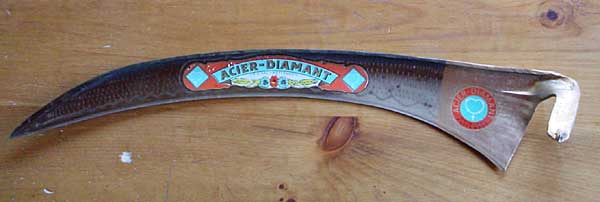 |
#3
50 cm. - 550g. $75
60 cm. - 540g. $84
70 cm. - 610g. $96 -- Sold out
Tang 42°
Made in Germany for the Belgian market more than 40 years ago. Read also the descriptions for #19 and #30.
 |
#4
60 cm. - 440g. $84
Tang 30°
Close to age and quality of #16, this is still a bargain in now non-existent workmanship. Its tang (acutely tilted toward the point) does not make it a good match to the common snath models as they are. However, should you retrofit them -- or for a homemade snath of any style, albeit one with ergonomically placed grips -- this tilted tang feature is excellent.
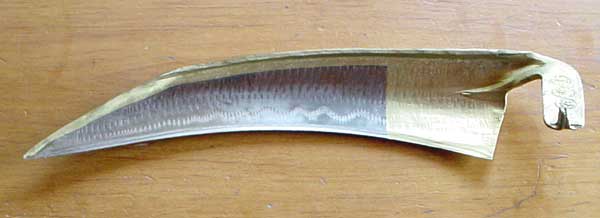 |
#5 - Sold out
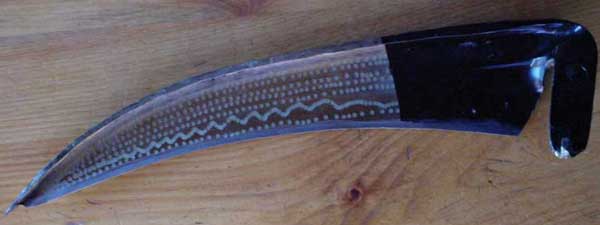 |
#6 - Sold out
 |
#7 - Sold out
 |
#8
65 cm. - 480g. $86
Tang 24°
 |
#9 - Sold out
 |
#10 - Sold out
Underneath the pretty fairy-tale label is an example of now-obsolete workmanship. (The caption in German reads, "Jokele, you go on ahead. You have the best blade.") Although this could be said of many blades in our present selection, in some cases it is more so than others...
By the early to mid 1980s the world's best scythe blades were very likely forged in one of two factories. This meticulously-finished batch from the same period was made in one of them. Although those hammers stopped moving 20 years ago, in careful hands these blades should last a mower's lifetime and a half...
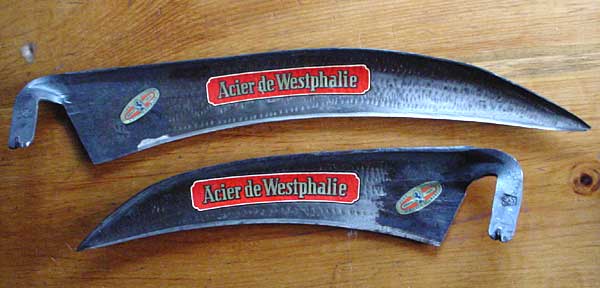 |
#11
53 cm. - 510g. $55
57 cm. - 540g. $60
65 cm. Left Handed - 565g. $70
50 cm. Left Handed - $55
Tang 30°
These were made in the late 1970s for Argentina, where they served as the general-purpose blade. According to the somewhat arbitrary classification of blade types presently used (an issue we address here), this fits somewhere in the "ditch" category. For the economically-oriented mower, these blades are a bargain.
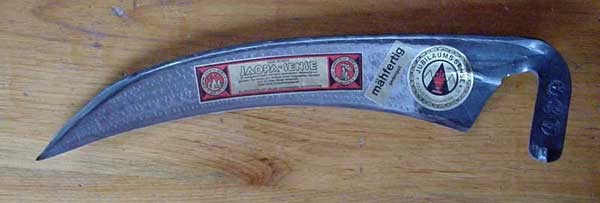 |
#12 - Sold out
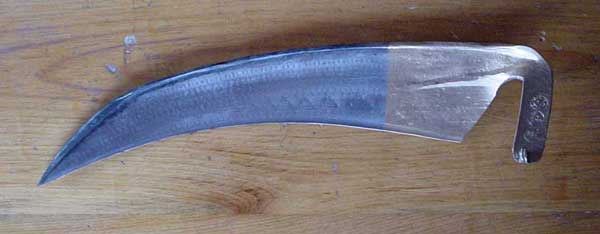 |
#13
55 cm. - 550g. $64
Tang 28°
For similar purposes as #12, with slightly more weight and length. The steeper tang is more suited to taller people and/or straight snaths.
#14 - Sold out
 |
#15 - Sold out
#16 - Sold out
#17 - Sold out
 |
#18
60 cm. - . $68
70 cm. - 565g. $78 Tang 28°
From our present listing this is probably the most abuse-tolerant blade. We could call it a hefty "grass" blade (because you can peen its edge thin enough to cut a lawn) or a "ditch" blade (because most ditches can be cleaned up with it) or even a "bush" blade (because, given good technique, green saplings of most woody species can be cut without damaging it).
 |
#19 - Sold out
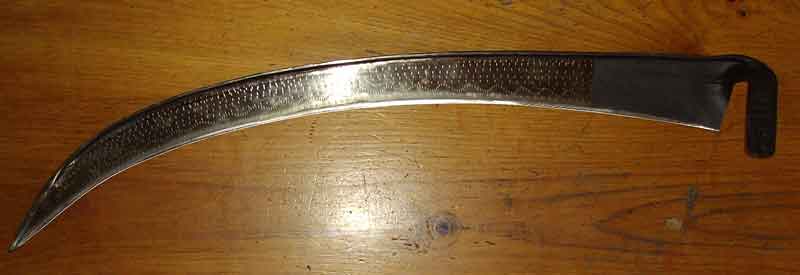 |
#20 - Sold out
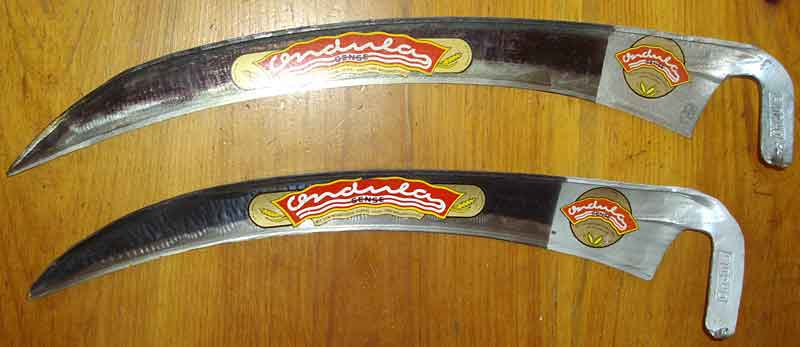 |
#21
60 cm. "A" - $85 - Sold out
65 cm. "A" - 480g. Tang 35° $90 - Sold out
60 cm. "B" - 420g. Tang 28° $90
65 cm. "B" - . $95
We wish we could offer these (especially in the "B" version which is older) in every length from 55 to 90 cm because they represent about as ideal a weight/length/strength relationship as any scythe blade. But we can't; made from 30 to 40 years ago, these are the last of them to be had...forever.
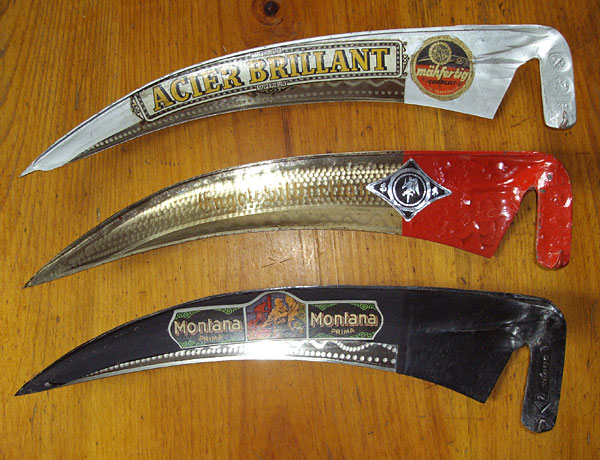 |
#22
A (silver) - 50 cm - 340g. - Tang steepness 22° - $78.00
B (red) - 50 cm - 370g. - Tang steepness 24° - $82.00
C (black) - 50 cm - 370g. - Tang steepness 22° - $78.00
Previously we had another nice blade (now listed as #100 in the Italian blades section) in this place. This trio of light short blades might look too delicate for cutting the odd sapling and various weeds in tight places but that exactly was their application 50 years ago. However, we consider them to be too special to be recommended for insensitive hands. Made by Sonnleithner of Austria in the early 1960s -- the era of superb workmanship.
 |
#23
16"/43 cm. - $70 - Sold out
18"/47 cm. - 400g. Tang 26° $74
20"/53 cm. - 440g. Tang 26° $78
22"/57 cm. - 460g. Tang 26° $82
#23 - Made in 1979 for Spain. (Tang is stamped with Spanish inches which are longer i.e. 20" = 53cm) The 16" is a slightly heavier model. Fine example of Austrian workmanship of that era.
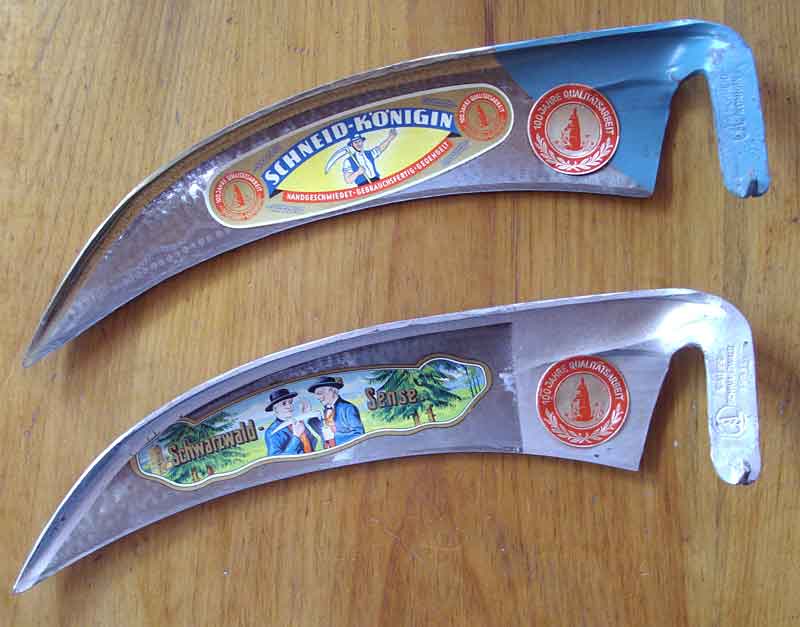 |
#24 - Sold out
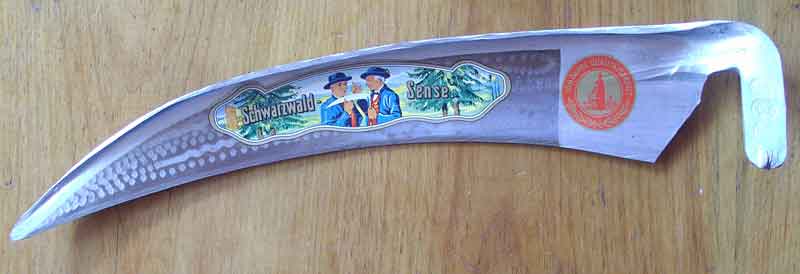 |
#25
55 cm. - 400g. Tang 24° $82
A trimming blade with a rather highly elevated Alpine-style point. Product of South Germany's industry of mid to late 1960s, an era of still superb workmanship. Appropriately strong neck and back but with a thinner body than #12 or #27 and thus not recommended for rough hands.
 |
#26
70 cm. - 735g. Tang 40° $92
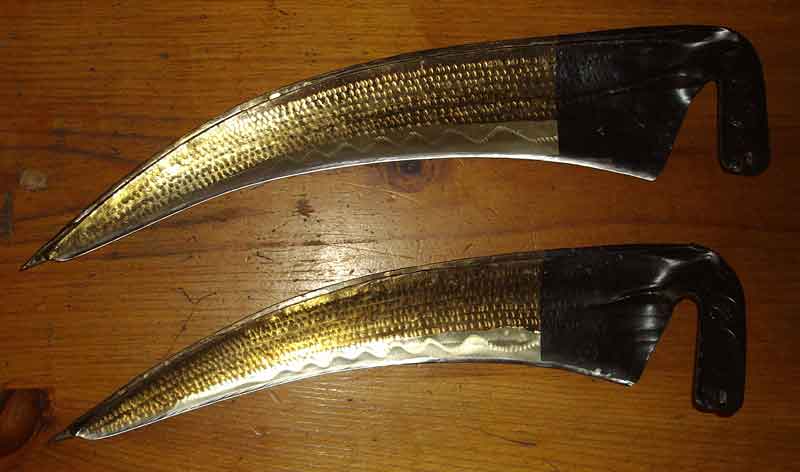 |
#27 - Sold out
 |
#28
30 Zoll/78 cm. - 790g. Tang 38° $125
 |
#29 - Sold out
 |
#30
75 cm. - 765g. Tang 25° $95
In contrast to the only other 75cm blade we presently offer (#2 - which is about as light as a scythe blade could be made today), this one is as strong in the back and neck as a 75cm ever needs to be.
Whatever is explained about blade #19, in principle applies to this blade (as well as #3 and #29); all are the product of the same enterprise during approximately the same period. All are very strong but come with edges initially not well suited for cutting of fibrous material.
 |
#31
55cm - 482g. - $84
60cm - 510g. - $86
Tang 28°:
Stronger than necessary for what would probably be considered an average scythe task -- but within the category evidently popular by the average user on this continent today.
32, 32, 34....
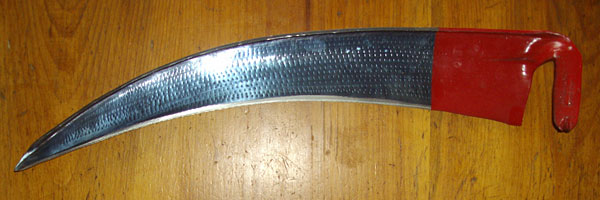 |
#35
60cm. - 490g. - Tang 24° - $75.00
A French model made by Schroekenfux (Austria) in 1982.
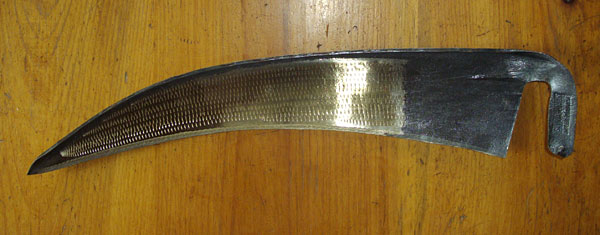 |
#36
65cm. - 530g. - Tang 26° - $84.00
A slight variation of #35, a little older and with its point somewhat more elevated.
Italian-made Scythe blades
#101, #102, #103 and #109 are of contemporary production; the rest are left over from the period between approximately 5 and 40 years ago. All, in our opinion, are fine pieces of steel to have mounted on the end of a snath. Their weight is in all the right places (meaning the necks are strong and the points light), the overall tension excellent and the workmanship beautiful.
 |
#100
65 cm. - 370g. - $74.00
Tang steepness - 28°
We had previously listed this blade as #22, but because it was made in Italy, we have now moved it to this section with its "blood family". It is of a somewhat recent production, but is one of the models now discontinued from Falci's standard program. This is the blade we used in the "brush" cutting demo and how we described it last year:
One of the patterns preferred in Turkey, where heavy blades seem to have been a taboo, this is the lightest per cm. of our listings. For that reason it may be (along with #2) the best for children. It is, however, stiffer than #2 and, although we do not recommend it as a "bush" blade, in experienced and/or sensible hands, green poplar, willow, alder, spruce, fir etc. saplings can be cut with it. All in all, I think that this sweetheart of a blade is worth its weight in precious stones...
 |
#101
SOLD OUT
70 cm. - 465g. - $80.00
Tang steepness - 22°
Along with #102 and #104 this model has been popular in Northern Italy and many other Alpine regions.
 |
#102
55 cm. - 390g - $65
65 cm. - 460g - $74 Out of Stock
Tang steepness 30°
Recent production of one of the most popular contemporary (albeit by design very old) models. Neither extremely light nor unnecessarily heavy, it is, in our view, a blade with a rather universal applicability.
 |
#103
70cm - 450g. - $77.00 - Out of Stock
75cm - 510g. - $82.00
85cm - 560g. - $94.00 - Out of Stock
90cm - 600g. - $98.00 - Out of Stock
Tang steepness: 28°
Similar pattern to our Austria-made blade #2, this is a typically "Eastern" model (Romania, Turkey, Iran, etc.) The tang, however, is too acutely hafted to function well on most common snaths. (More on this later)
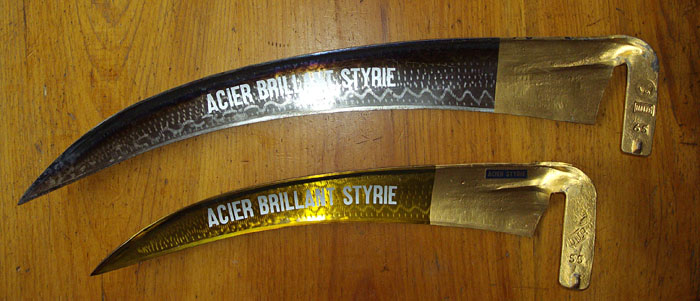 |
#104
55cm - 345g. - $75.00
65cm - 445g. - $85.00
Tang steepness: 22°
With somewhat more elevated and straighter point than was typically used in much of Italy; more of an Alpine-style model (seen here dressed in two editions).
 |
#105
55cm - 455g. - $78.00
60cm - 510g. - $84.00
Tang steepness: 30°
Why the image of a North American Native (who had no use for a scythe) would be used as a trademark is quite beyond us. Interestingly, both Austrian and German industries once did the same thing -- and on blade models which this continent never saw. This specific model is as typically Italian as the original version of lasagna. The body is rather flat, stiff and with a low point. (As explained elsewhere on this site, it is easier to cut a stubble without "steps" with a low-pointed blade than with for instance the classical Austrian pattern.)
 |
#106
60cm - 495g. - $90.00
Tang steepness: 28°
This is a special edition of nearly the same model as #105, really a collector's item. (Very limited supply).
 |
#107
55cm - 440g. - $82.00
Tang steepness: 28°
Very similar to #105 and 106, but of still older (30+ years) production.
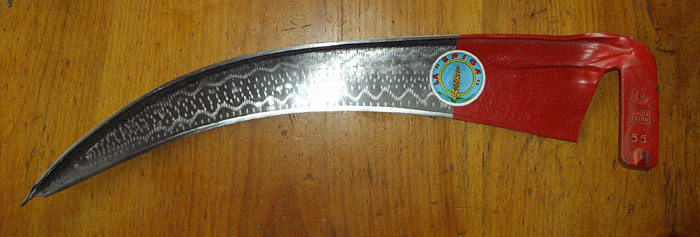 |
#108
OUT OF STOCK
55cm - 450g. - $65.00
Tang steepness: 28°
Dressed the same as #101, this is nevertheless a different model which, along with #109, are amongst the "ditch" blades most widely used in Italy today.
 |
#109
OUT OF STOCK
50cm - 420g. - $60.00
Tang steepness: 28°
Another Indian portrait on a more contemporary blade. Similar to #108 but a little lighter; otherwise the description above applies.
 |
#110
50cm - 300g. - $78.00 (pre 1980s make)
55cm - 350g. - $75.00 (mid to late 1980s)
60cm - 410g. - $80.00 (mid to late 1980s)
Tang steepness: 28°
 |
(click for more photos)
#111
OUT OF STOCK
70cm - 470g. - $111.00
Tang steepness: 28°
Practically the same model as #102, but approximately 40 years old. An extraordinarily beautiful as well as high quality blade. The iridescent finish (once used by Austrian makers as well) is now a thing of the past.
Group Discounts for Educational Purposes
Whenever intentional communities, transition town groups, etc. plan to organize hands-on workshops and/or just want to have on hand several "practice scythes" for visitors or beginners to try out, we can put together diverse packages at a discount off our regular prices.
Contact us for details (but please do some preliminary homework beforehand; read information on selecting a scythe here.
"A man whose mind is enlightened with a knowledge of mechanical principles, will never bend nor break a spade; his keen perception will tell him, even if he were blindfolded, when the strength of the spade is unequal to the force applied to the handle".
- S.E.Todd, The Young Farmer's Manual, 1860
Of course, this timeless observation applies to women as well as men, and to all other tools besides spades.
Shipping rates:
Within Canada:
For one to two complete units - snaths, up to 4 blades, accessories - $40
For one to four blades and accessories: $30
Any other combinations; please contact us.
To the U.S.
$55 for one to two complete units;
$35 for one to four blades with accessories.
Any other combinations, contact us.
Overseas Estimates:
Under 1kg. and up to 80cm long: $50 for surface (6-8 weeks) and $90 for air (10 days). This rate covers a blade and ring, and possibly a whetstone. A 10kg. parcel (80cm length) is $110 by surface or $230 air. Snath shipping is prohibitively expensive: $300-400!
Contact us for a quote, or better yet, find an alternative source here.
Ordering:
All prices are in Canadian dollars.
We do not, and likely never will, accept credit cards or other forms of electronic payment. If you feel moved to bypass the corrupt banking system, sending cash in an envelope is fine. The next most expedient option is a postal money order or bank draft (for US residents: specify an 'International money order'). A personal check takes one to two weeks to clear.
Checks or money orders should be made out to Ashley Vido, (not ScytheConnection) and mailed to:
1636 Kintore Rd.
Lower Kintore, New Brunswick
E7H 2L4 Canada
OR to our mailbox in Maine -- but PLEASE send an email before mailing anything to this address, as we only check it sporadically:
26 North Street, P.M.B. 161
Presque Isle, Maine 04769
23 May 2006
Modified 14 Oct. 2012